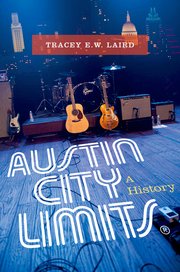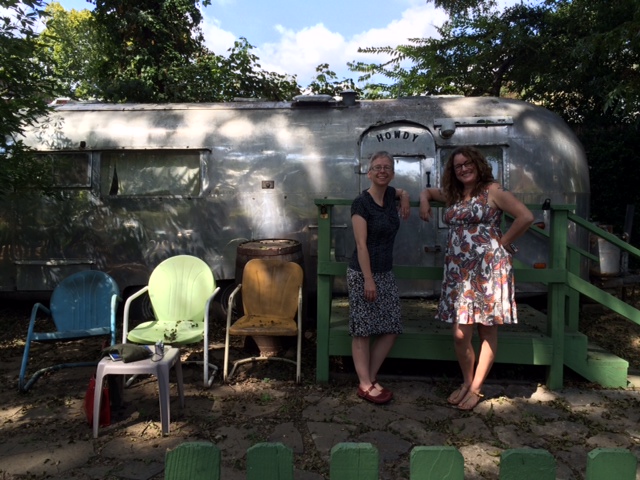Austin City Limits: A History
Austin City Limits recently celebrated the 40th Anniversary of its first television episode — one that featured Willie Nelson and aired on October 17, 1974.
Tracey E.W. Laird’s new book, Austin City Limits: A History, is a really fun read that does a fantastic job of exploring the phenomenon of ACL – not just in and of itself (which is already pretty interesting), but also what it points to outside of itself; the development of a musical showcase not identified with one specific genre, the regional identity of Austin, and the changes over the last 40 years in the ways in which audiences are exposed to new music through the media.
Laird is Professor of Music and Chair at Agnes Scott College in Decatur, Georgia, and her academic background shows in the very clear and precise framework she sets up to tell the story. You always know exactly where you are and where you’re going, and how the part you are currently reading relates to the other parts. At the same time, Laird has an uncanny ability to describe the events that lie at the very heart of Austin City Limits – the sublime, transformative, not-of-this-earth experiences that arise from live music performances. As Laird points out in the book, part of the show’s success lies in the fact that more than any other televised music showcase, Austin City Limits successfully conveys the feeling of being an audience member in a small club.
Austin City Limits: A History provides detailed information on how that small club experience was and continues to be brought across to television via the efforts of a small band of wizards and visionaries including; Bill Arhos (the show’s creator and later KLRU station general manager), Terry Lickona (producer since 1979), Gary Menotti (director), David Hough (sound engineer and longest-running staff member, having been with ACL at the taping of the first episode), Scott Newton (photographer since 1979). It’s really cool reading Laird’s descriptions of these staff members’ careers. She has attended at least 14 tapings and has a long-standing friendship with many of these people, so they speak candidly and naturally with her and their personalities come across in her interviews with them.
A few items that stood out for me:
- Bill Arhos’ courage and determination in selling and defending such an esoteric show to PBS programmers across the nation
- Terry Lickona booking an hour of Tom Waits on his first season as producer in 1979
- Gary Menotti watching rehearsals with a stopwatch so he’ll know which camera to cue at which points in the live performances (note: the precision and planning required to bring across a feeling of seamless spontaneity)
- David Hough managing to make the music sound good even when played through mono TV speakers – and so successfully so that even very particular artists trust him with the mixes
- Scott Newton describing the essence of his job: “So the performer up there, yeah, that’s a person in a body, but when they’re performing, there’s something else. They’re channeling that deeper thing. They’re channeling the divine. That’s what I find interesting, and that’s what I’m trying to photograph.”
I’m amazed by all of these people. Others mentioned in the book are equally fascinating, but I’m short on space here . . . so, just buy the book. If you’re starting to think about gifts for family members for the holidays, this book will fit the bill for lots of folks.
I recently met with Laird for lunch at Shady Grove, my favorite local restaurant, which just happens to be about a half mile away from Zilker Park, where the ACL festival takes place. She was every bit as intelligent, witty, knowledgeable, and insightful as one would expect from reading her book.
We talked about the difficulties that ACL television producers faced in marketing a show that features acts who do not fit neatly in any specific genre and/or bringing forward bands associated with different genres and making it all work together. She noted that, “now, it’s totally coherent to have Jack White, Mavis Staples, and Rodrigo y Gabriela on the same season.” I told her about my recent blog post about the genre-defying John Wesley Coleman III, about which she remarked that there was a time when a group like that would have been coached to be more of one thing, but now there is space for people to contain multitudes (a reference to the most famous lines of Walt Whitman’s poem “Song of Myself”).
Perhaps the Austin City Limits television show has been instrumental in helping radio and television programmers, as well as listeners, in creating that space for artists to contain multitudes. In her book, Laird gracefully lays out the history of how that came to be, and introduces us to the staff members who made it happen.
We also spoke about Austin City Limits as a place to discover new music. I related to her a time when my husband and I happened to catch Austin City Limits one night, and we sat transfixed and didn’t say one word to each other for half an hour as we watched Bright Eyes perform. We had heard of him, but he wasn’t someone we would normally have seen if it hadn’t been for ACL. Laird said that that was a common experience. This was underlined for me last week when I watched the 40th anniversary special of Austin City Limits. Although most of the program was pretty mild-mannered and somewhat predictable, Alabama Shakes was a huge and wonderful surprise. I was floored, and became an immediate fan. I don’t think I would ever have heard of them if they hadn’t been on ACL.
So, thank you to ACL for allowing us to realize just how many multitudes we can contain.
And especially thank you to Tracey E.W. Laird for writing such a passionate and precise history of the phenomenon, which started as a television show featuring “free form country folk rock science fiction gospel gum existential bluegrass guacamole opera music” and has continued to inspire and amaze several generations of listeners.
In a final note, we talked about the City of Austin’s role in this whole thing. She described Austin as a “crossroads for all kinds of different people, kind of mixing it up” and as having a “wide-open spirit.” In the book she describes how the term “progressive country,” which came to describe ACL’s sound during the early day’s of the program, drew on “the romance of Texas legend and Austin iconoclasm.” Well put.


